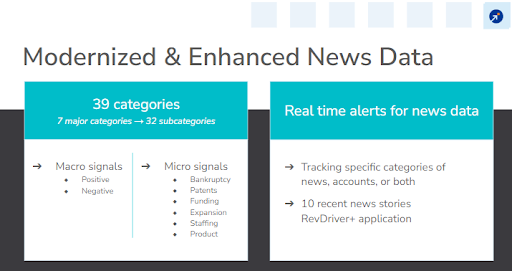Everyone has probably heard a lot over the last several years about the massive change that we’re going through with how B2B products are bought and sold. It’s much less about long-term, in-person sales relationships with playing golf and going out to dinner, and much more about customers having their self-led journeys, most of which do not interact with the sales team until they have already decided to buy.
This is where intent data is becoming increasingly important in the B2B industry as buyers’ buying approach is changing. Intent data helps you start a conversation with buyers while they’re still in their decision-making process and provide the ideal materials they are looking for. By contacting buyers before your competition, you increase your chances of winning the deal.

Intent data refers to the digital signals that indicate a prospect’s interest in a product or service. These signals can be collected from various sources, such as search engines, social media, and website behavior.
One of the key benefits of using intent data in the B2B industry is that it allows marketers and sales teams to understand their prospects’ behavior and interests in real-time. By analyzing intent data, businesses can identify prospects who are actively searching for their product or service and tailor their marketing and sales strategies accordingly. This helps businesses to focus their resources on the prospects who are most likely to convert and generate revenue, improving the efficiency and effectiveness of their marketing and sales efforts.
If you’re among the tens of thousands of companies struggling to build and close pipeline predictably in 2023, we want to share how intent data is one solution you can use to get a leg up.
We’ll explain six flavors of intent data and how to use them. By combining intent information, you surface ideal customers that are in-market based on technographic and firmographic data. Your sales team will have access to ideal customers with buying intent to prioritize for outreach. And, by contacting companies while they are still in the buying process, you increase the chance that you are chosen over a competitor.
Intent data makes it easy to achieve ideal sales operational outcomes and get your team operating far more efficiently for mid-size teams and large enterprises. Intent data is the secret to hitting above your weight class and grabbing an increased market share.
Here are six intent data types we will cover in this blog:
- Bombora Company Surge® Intent
- Predictive Intent
- Foundry Intent
- 1st Party Intent – Website Visitor Resolution
- News & Alerts
- Contact & Company Change Data
1. Bombora Company Surge® Intent
The internet’s a big place. At least 95% of it has nothing to do with B2B buying. Bombora curates an ecosystem that ignores all of that and focuses only on B2B buying intent signals. These are intent signals like engagement with niche verticals, trade publications, and broader business news sites like Wall Street Journal, Bloomberg, and Forbes.
Additionally, Bombora focuses on lead generation, webinar signups, event signups, etc. They have created a value exchange with the media companies and other constituents that control this content. The idea is to have a technology monitoring this ecosystem that Bombora created holistically and share with customers when companies show intent within the ecosystem.
Bombora intent data is also included with SalesIntel.
Difference Between Bombora vs BidStream
Bombora:
- Data Co-operative: a highly curated collection of 5000+ B2B websites with the most complete coverage of B2B buying signals.
- Exclusivity: Co-op members opt-in and implement a tag that collects 100% of content and consumption info from participating websites.
- Quality: Company Surge® data science methodology identifies changes in content consumption compared to historic baselines.
- Privacy: Each Co-op member obtains explicitly informed user content for Bombora’s use of data.
BidStream:
- Data passed from ad exchanges to targeting platforms; Collected exclusively from ad impressions up for auction.
- Collected from any website with advertising space available through ad exchanges on ONLY the ad impressions available for auction.
- Intent is scraped from web pages when businesses interact with keywords, without any notion of context or cadence of interaction.
- Bidstream is under investigation for privacy compliance; Non-compliant with GDPR.
Bombora intent data can help drive qualified demand through the funnel and unify sales and marketing across the customer journey.
Bombora Company Surge® Intent can be integrated throughout your tech stack and used to initiate many use cases ranging from account prioritization to sales enablement and customer renewal.
2. Predictive Intent
SalesIntel recently introduced an advanced feature called PredictiveIntent, designed to enhance the existing array of signals. This innovative feature aims to identify and engage potential prospects earlier in their research phase, thereby enabling businesses to establish an early brand presence and convert these prospects into valuable leads. The primary objective is to identify companies displaying initial interest in the product, allowing marketers to strategically tailor their marketing efforts, content, and advertisements to drive engagement and website traffic effectively.
Under the PredictiveIntent framework, several key indicators serve as valuable signals. For instance, observing changes in technographics within a company serves as an indicative sign of potential growth. Similarly, tracking job changes within organizations and the opening of new branches are also significant signals. These signals play a critical role in preventing customer churn, supporting existing clientele, and identifying growth opportunities, thus facilitating the development of more precise and effective customer targeting strategies.
3. Foundry Intent
Foundry Intent unifies real-time signals from a variety of sources to deliver a high-fidelity source of B2B buyer intent within a single platform. The product aims to support B2B marketers as the technology buying journey becomes increasingly dispersed by consolidating and scoring varied signals for a single, actionable view of both account and buyer-level intent.
Foundry Intent data is captured and used to predict the likelihood of an organization being in the market. The data is primarily centered around Foundry’s proprietary and first-party data. Second-party data is gathered from people showing behaviors on Foundry’s owned and operated properties. They host over 1,000 events and capture that lead generation details.
Foundry is all about a ton of rich data that’s not just content consumption. They look at technographics, hiring trends, tech spend data, contract renewal data, event attendance, and if the prospects mention anything in their SEC filings or press releases. Foundry captures all that data and combines it to find the companies most likely to be in-market for your product.
4. 1st Party Intent – Website Visitors
Marketers are familiar with gathering intent data from their own website visitors. Every marketing team uses it, but be aware that it’s most powerful when complimented with a more scaled signal as you get from Bombora and Foundry.
Here at SalesIntel, we provide VisitorIntel to monitor website traffic as part of what we do in combination with intent data. When we see those anonymous website visitors, we’re able to resolve them with the company behind that anonymous visitation. This is first-party data.
You’re within your rights to understand and know the companies visiting your own website. It’s one of the more powerful capabilities out there.
For example, at SalesIntel, there are 26,324 companies matching our ideal customer profile and showing intent where we are three times more likely to win, where our ACVs, retentions, expansions, and lifetime value are three times higher.
So, if your team and marketing efforts are focused on that lens, right away, your team can be six times more efficient than it is today. And if you layer on other intent signals, not only do you have the ability to focus on your ideal market, but you are also focusing on who’s actually in the market. You can separate people just browsing from those looking to buy.
You send that signal to your sales team, you send that signal to your content syndication play, and then finally combine it with our decision-maker contact information. It’s a really powerful combination that puts you ahead of your competition.
How It’s Done:
- Reverse IP Lookup:
Know which companies are visiting your website and track their visiting behavior to collect key intent data points.
- Actionable Insights:
Use VisitorIntel to match anonymous website visitors to your Ideal Customer Profiles, so you can maximize conversions with data that instantly connects you with decision-makers.
- Human-Verified Data:
Build effective connections with decision-makers, thanks to our 95% accurate contact data. If you can’t find the exact contacts you need, request our research team to find them.
Why It Matters
- ABX Fuel:
Key information to better understand the ‘in-market’ potential of accounts in your ICP.
- Paid Advertisement Audience Builds:
Key to creating a targeted list of solution-aware accounts for retargeting campaigns.
- Lead Scoring:
Equip your sales team with priority leads.
- Account Research:
Map out your account research and see if your expectations align with reality.
- Opportunity Insight:
For example, a company may have halted a sales conversation but still be viewing your site regularly.
5. News And Alerts
You might think that this doesn’t fall directly under intent data. However, when you operationalize how you use intent, there are a lot of other signals that are used the same way within your team and can have a lot of impact. One is absolutely news and alerts.
Why are news and alerts so valuable? They give you information about new funding, executive hires, and more. You’ll see strategy updates to the company, a press release, a product news story, an expansion, and M&A. There are tons of signals out there. Those alerts or signals are signals of change, strategy change, leadership change, a champion that is a current customer now going to another company, a job changer, or conversely a champion at one company exactly coming to your ICP that wasn’t there before.
These signals are really powerful when used along with other intent data. The way you act on them is similar. When a company change is occurring it often brings opportunity.
With SalesIntel, our news and alerts have 39 categories. We’ve got seven major categories and 32 subcategories.

At a macro level, there are general positive and negative signals. On a micro level, we might know about bankruptcy, patents being filed, funding announcements, et cetera. The key is to have the ability for alerts to be issued off this data.
When those signals fire, they’re going to come right into the salesperson or marketing team’s world, “Hey, here’s a group of people or companies with a change signal based on news that matters that we should act on.” It’s a useful signal to pay attention to, and it’s easy to integrate into your tools and workflows. In SalesIntel’s case, it’s built right into our tool and what we do every day ourselves.
Want to see how it works using SalesIntel?
6. Contact & Company Change Data
In your own CRM or your B2B Intelligence provider like SalesIntel, you should be proactively monitoring job changers and looking for people no longer at an important customer. Or, if there are a group of contacts that you’ve been trying to work with from an outbound perspective, and you see those contacts change or you see new contacts coming in, then that all should be operationalized and acted on. You’re looking for signals that show new opportunities for conversation.
Company data, technographic data, is another form of intent signal that you can use. For example, when we see a smaller team upgrade to a new marketing automation platform that we integrate with, whether it’s HubSpot or Marketo, that is a great signal for us. You know their marketing capabilities are moving forward. They’re up-leveling. They’re becoming more sophisticated, and we are a good fit for a company that’s moving into the growth stage. Those signals are powerful to us, so we can monitor new prospects using our technographic data.
Technographic and firmographic data can show you prospects moving into your ideal client profile that you should prioritize for outreach.
Start Right, Start Now
As buyers have more information and options than ever, intent data is a crucial tool that can help businesses stay ahead of the curve and succeed in the highly competitive B2B industry. Reaching customers first increases your win rates and sales velocity.
If you have a big demand gen budget and your pipeline machine is running putting intent data into that part of your marketing funnel might be a great place to start. If you have a small SDR team, but you don’t have a big marketing budget, then outbound SDR could be a good place to start with intent data.
Don’t make the mistake of ignoring all the other work you’ve done with your go-to-market strategy. Don’t throw it all out and just leverage intent data. Not every company showing intent is a good fit. Layering intent data with your go-to-market plan and ideal customer profile makes you hyper-efficient, improves win rates, and leads to better-quality meetings.
So, start right, start now! Schedule a SalesIntel demo to see your potential yet untapped market and get a head start on your competitors.




